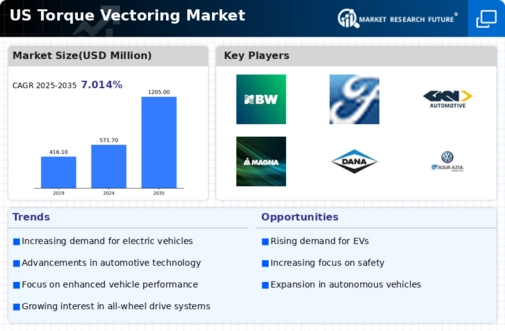The US Torque Vectoring Market is characterized by its dynamic nature, driven by ongoing advancements in automotive technology and an increasing demand for enhanced vehicle performance and safety. The market encompasses various automotive manufacturers and suppliers who are innovating to provide solutions that enhance vehicle stability, control, and handling. As electric and hybrid vehicles gain prominence, the need for sophisticated torque vectoring systems is rising, owing to their ability to efficiently manage power distribution between wheels, thereby improving traction and maneuverability.
The competitive landscape is marked by a mixture of established automotive giants and emerging players all focusing on research and development to capitalize on the opportunities within the torque vectoring sector.
Toyota Motor Corporation has solidified its presence in the US Torque Vectoring Market by consistently prioritizing innovation and quality in engineering. The company's strengths lie in its formidable reputation for producing reliable vehicles, complemented by advanced technology integration that enhances driving dynamics. Toyota has adopted a proactive approach to developing torque vectoring systems, which not only improve the performance of internal combustion engines but are also pivotal in their hybrid and electric models.
Their commitment to sustainability and efficiency further positions Toyota as a leader in this market, allowing them to leverage their extensive experience in vehicular technology to cater to the evolving demands of US consumers and maintain a competitive edge in torque vectoring innovation.
BorgWarner is a recognized player in the US Torque Vectoring Market, known for its focus on delivering advanced powertrain products and propulsion systems that enhance performance and efficiency. The company offers a range of torque vectoring solutions that include electronic and mechanical components designed to optimize vehicle dynamics. BorgWarner's strengths are underscored by their robust engineering capabilities and commitment to research and development, which allows them to introduce cutting-edge technologies to the market. They have been active in expanding their portfolio through strategic mergers and acquisitions, strengthening their market position and enhancing their product offerings.
This proactive approach positions BorgWarner favorably in response to the rising demand for high-performance torque vectoring systems in the US automotive landscape, enabling the company to effectively address the functional needs of modern vehicles while adhering to environmental standards.


















